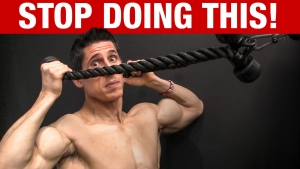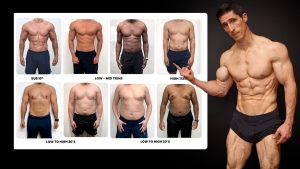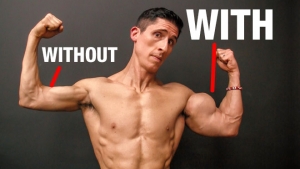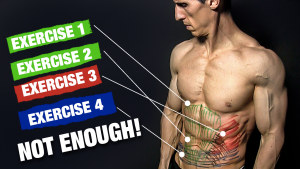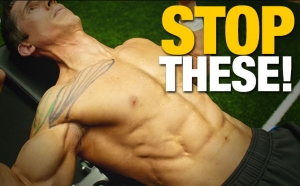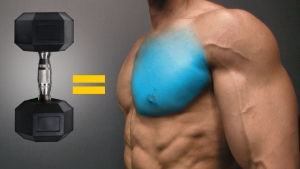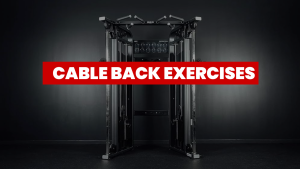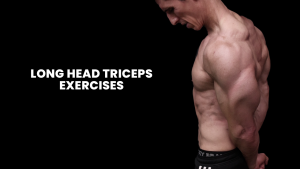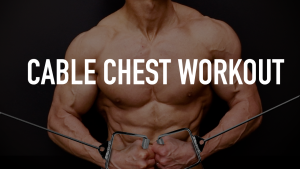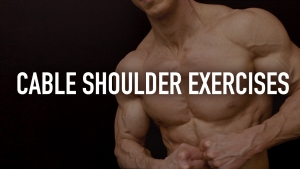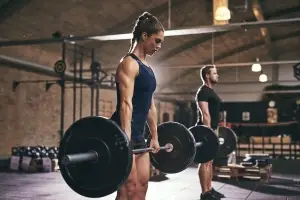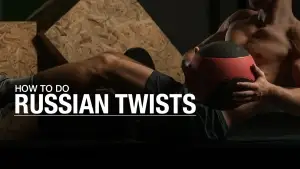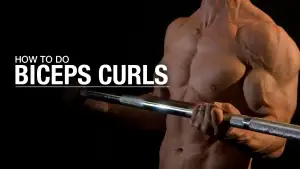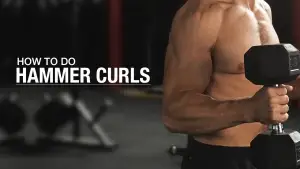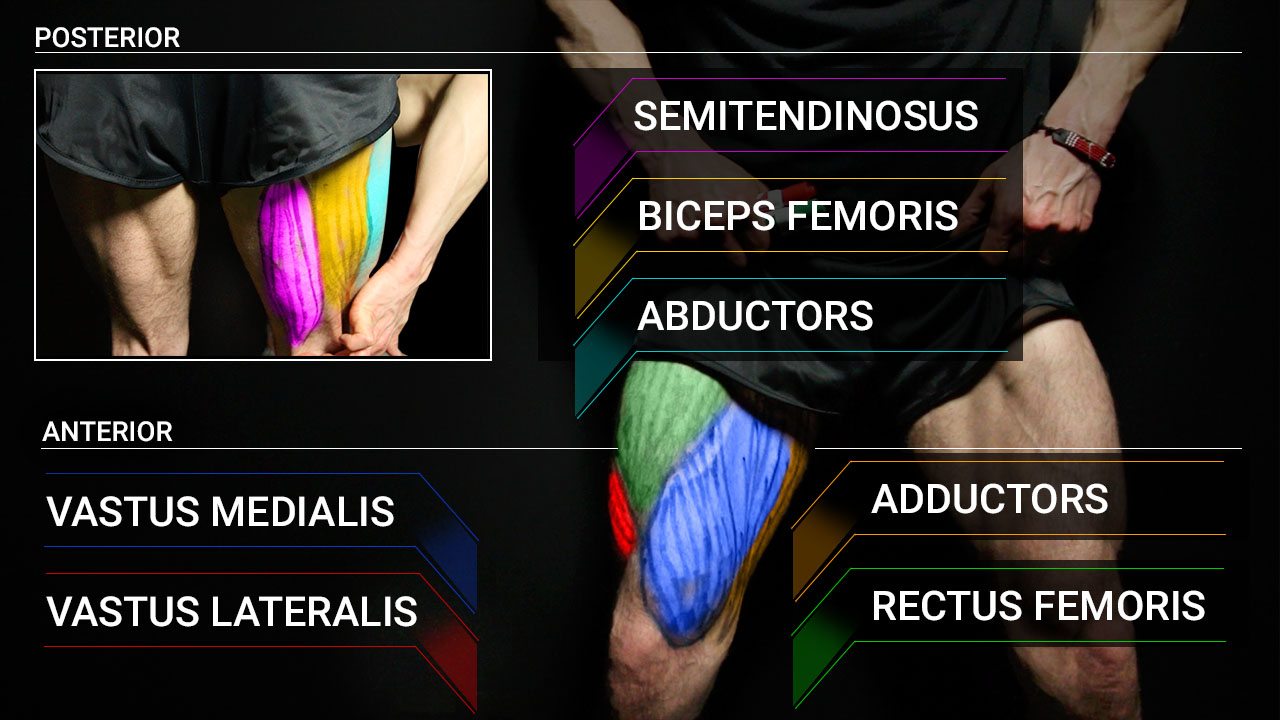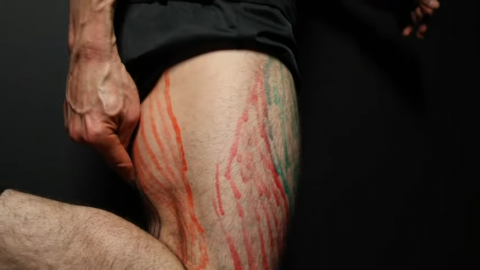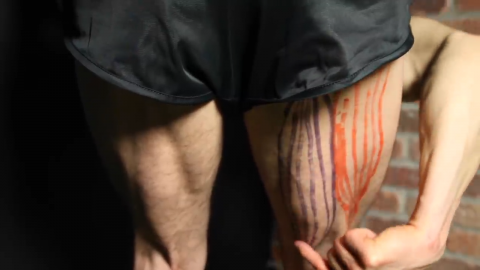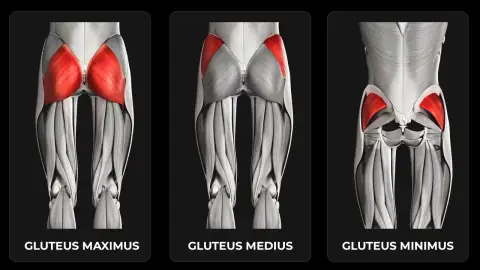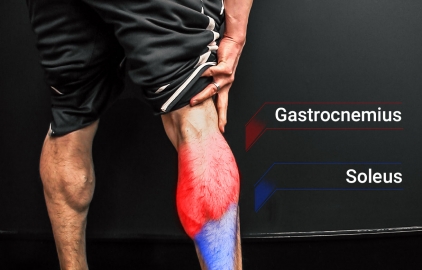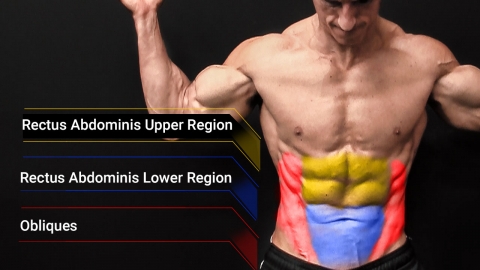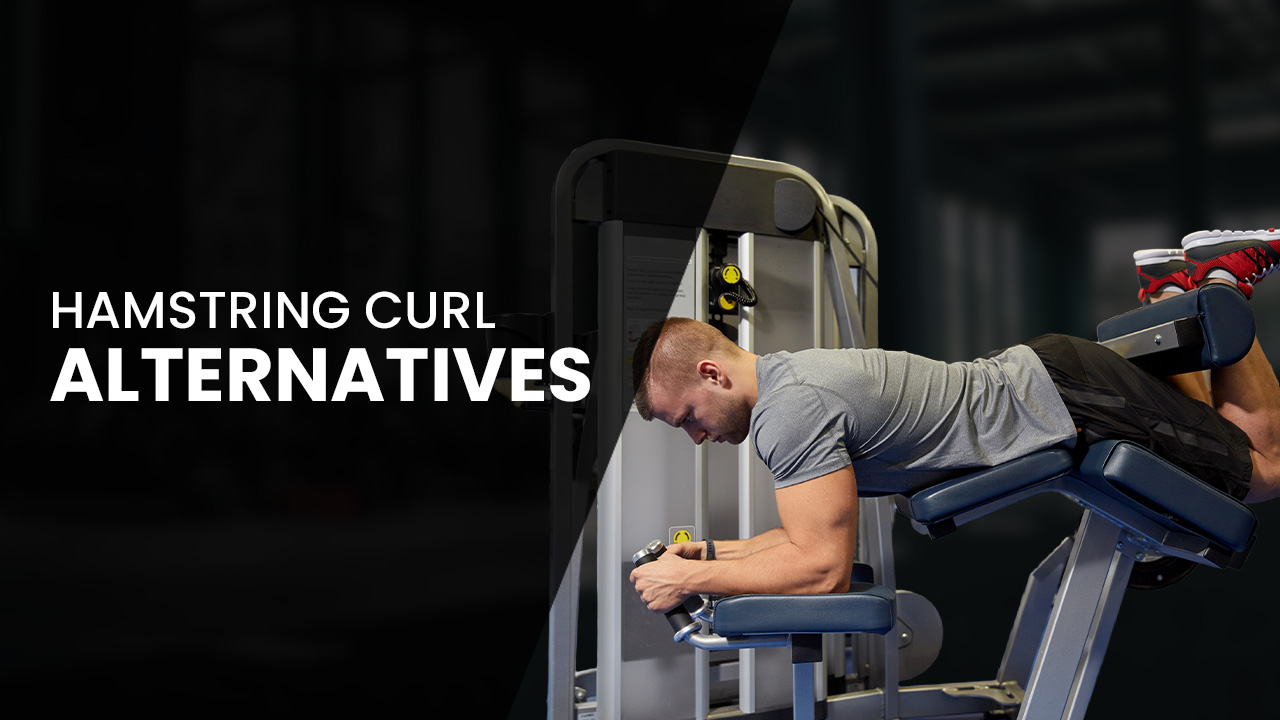
WHY not hamstring curls?
On paper, this probably seems smart. When you perform Seated Leg Curls, you know you can feel the muscle working. You probably even get a nice pump afterwards.
But the problem here is functionality.
Your hamstrings don’t just bend the knee. They stabilize it, decelerate it, and even help straighten it when you’re on your feet.
If you only train your hamstrings with curls, you’re not building protection. Instead, you’re programming weakness and setting yourself up for injury.
Hamstrings need to be challenged through stability, loaded in lengthened positions, and trained as part of the larger posterior chain, not isolated in the weakest part of their range on restrictive gym equipment.
That’s why relying on the Leg Curl machine or its variations is one of the fastest ways to stall progress and set yourself up for muscle imbalances.
Today, I’m going to cover the muscle groups involved in hamstring curls, why the traditional hamstring Curl isn’t the smartest option, and which alternatives deliver the kind of strength, growth, and durability that you’re looking for.
HAMSTRING CURLS: MUSCLES WORKED
The Leg Curl machine is built to target the hamstrings, but the truth is the hamstrings never work alone.
They’re part of the posterior chain and function across both the hip and the knee.
That means when you only load them with a Lying Leg Curl machine or Seated Curl machine, you isolate a single action (knee flexion) while ignoring their much bigger role in hip extension and stabilization.
To understand why smarter alternatives like Romanian Deadlifts, Nordic Curls, or Glute Ham Raises are more effective for developing your leg muscles, you first need to know which primary muscle groups are involved and how they function.
BICEPS FEMORIS
The biceps femoris is the outermost part of the hamstrings, running along the outside of the thigh.
It has two heads: a long head that crosses both the hip and knee, and a short head that crosses only the knee.
This dual role makes it a prime mover in both knee flexion and hip extension.
While a Leg Curl machine or Barbell Leg Curl will activate it during knee flexion, its functional strength is best developed through hip hinge movements like Romanian Deadlifts, Good Mornings, and Split Stance Dumbbell Romanian Deadlifts.
Ignoring its hip-extension role creates a mismatch between how it’s trained and how it’s used in sport and daily movement.
SEMITENDINOSIS
The semitendinosus sits more toward the middle of the hamstring group and contributes heavily to both hip extension and knee flexion.
Its long tendon gives it leverage to stabilize the knee and control deceleration.
Isolation on a Seated Curl machine or Low Pulley Standing Ham Curls hits part of its role, but not the part that protects your joints in motion.
Functional lifts like Single-Leg Stiff Leg Deadlifts, Stability Ball Hamstring Curls, and Nordic Hamstring Curls provide the kind of muscle activation and eccentric loading that this muscle needs for durability and performance.
SEMIMEMBRANOSUS
The semimembranosus lies deeper, beneath the semitendinosus, and anchors closer to the inner thigh.
It’s heavily involved in internal rotation of the leg as well as hip extension. Because of its location, it plays a stabilizing role in the posterior chain, keeping the pelvis aligned during dynamic movement.
Machine-based work like the Lying Leg Curl machine under-emphasizes this stabilizing role.
Smarter alternatives like the Glute Ham Raise on a glute ham developer, Nordic/Russian Hamstring Curls, or even a Rower Hamstring Curl combine hip joint and knee mechanics, giving the semimembranosus the eccentric stimulus it needs for muscle hypertrophy and joint protection.
GLUTES (GLUTEUS MAXIMUS)
The glutes are the largest muscle group in the posterior chain and the primary drivers of hip extension.
While Hamstring Curls on a machine mostly ignore them, real-world hamstring function depends on the glutes firing together with the hamstrings to stabilize the pelvis and generate power.
Movements like the Glute Bridge and Hip Thrusts reinforce this partnership by loading the hip extension pattern directly.
Without strong glutes, the hamstrings are left to pick up the slack, often leading to strains or overuse injuries.
Training both together ensures balanced strength and protection.
CALVES (GASTROCNEMIUS)
The gastrocnemius, a two-joint muscle of the calf, also contributes to knee flexion because it crosses behind the knee.
This means it works alongside the hamstrings in flexion-based movements, though usually as a secondary player.
When performing variations like Prone Dumbbell Hamstring Curls, the calves assist by helping control the bend at the knee, ensuring you’re keeping movements smooth and stable.
While not the prime mover, the calves provide extra leverage and support during hamstring-dominant exercises.
CORE & STABILIZERS
Hamstring training isn’t just about the big muscles. It’s also about the stabilizers that keep the hips and spine aligned under load.
The core, especially your abdominal muscles, glute medius, and deep stabilizers fire to prevent rotation and maintain posture during complex movements.
Single-leg exercises are especially demanding here.
For example, Single-Leg Deadlifts not only target the hamstrings but also train balance, pelvic control, and spinal stability at the same time.
Ignoring these stabilizers, like when you’re only training on machines, leads to weak links that show up fast in athletic performance or under heavier loads.
WHY THE HAMSTRING CURL ISN’T THE BEST OPTION
When Leg Day arrives, the Hamstring Curl feels like the obvious answer. You sit down, bend your knees, and the back of your legs light up.
But just because you feel the burn doesn’t mean you’re training the hamstrings the way they’re designed to work.
The reality is, this machine locks you into a pattern that ignores how the hamstrings function, puts them under load in their weakest position, and leaves out the stabilizers that protect your knees and hips.
Here’s why you might want to reconsider Hamstring Curls as your go-to hamstring exercise.
TRAINS THE HAMSTRINGS IN ISOLATION
The hamstrings are never truly isolated in real life. Every sprint, jump, or hip hinge involves the glutes, calves, and stabilizers working together.
A Hamstring Curl strips all of that away and teaches the hamstrings to act alone.
That may feel good on a machine, but it doesn’t prepare them for the coordinated demands of sport or daily movement.
Strong hamstrings aren’t just strong in isolation. They’re strong when paired with the rest of the posterior chain.
IT STRENGTHENS THEM IN THE WEAKEST POSITION
Curls load the hamstrings in their shortened range, where they are least capable of producing force.
This is exactly where they’re most vulnerable to strains. Training only in that position builds a false sense of strength.
You feel the burn on the machine, but the muscle isn’t prepared to handle the lengthened, high-tension positions where injuries often occur.
Without eccentric training and hip extension work, your hamstrings may look developed but still fail under stress.
IT IGNORES THE HIP EXTENSION ROLE
Ask any athlete when their hamstrings matter most, and the answer won’t be “when I’m curling my heels to my butt.”
It’s during explosive hip extension like pushing off the ground, driving out of a deadlift, or powering through a sprint.
Machine curls don’t train this at all.
By leaving out hip extension, you’re skipping the hamstrings’ most important function.
That’s like training your chest with only the Chest Fly and never pressing. In other words, it misses the main job of the muscle.
IT CREATES MUSCLE IMBALANCES
The quads get plenty of compound work through Squats, Lunges, and Step-Ups, but when the hamstrings only get isolation, the strength gap widens.
Over time, this quad–hamstring imbalance loads more stress onto the knees and hips. It can even cause lower back pain.
It’s no surprise that lifters who rely heavily on curls often struggle with knee pain or recurring hamstring pulls.
Balance isn’t built by chasing symmetry in the mirror. It comes from training opposing muscle groups in their real functional patterns.
IT LEAVES STABILIZERS OUT OF THE EQUATION
When you’re strapped into a curl machine, your core, hips, and pelvis can check out completely.
But those stabilizers are what keep your spine safe and your pelvis aligned when the hamstrings are under load.
If they’re not trained, your hamstrings are strong in the gym but fragile in motion.
It’s the difference between strength you can show on a machine and strength you can trust in the real world.
HAMSTRING CURL ALTERNATIVES
If the Leg Curl isn’t the smartest way to train your hamstrings, the obvious question is: what should you do instead?
The answer is to stop chasing isolation and start training your hamstrings the way they function: under load, in lengthened positions, and alongside the rest of the posterior chain.
That means choosing movements that not only hit the hamstrings directly but also tie in the glutes, core, and stabilizers to build strength that carries over to real life.
Let’s run through the best Hamstring Curl alternatives that build size, strength, and resilience without the pitfalls of the curl machine.
SWISS BALL ROLL-OUTS

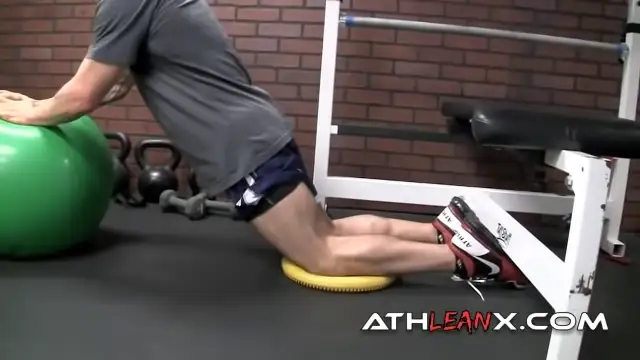
HOW TO DO SWISS BALL ROLL-OUTS:
- The starting position is on your knees with your feet anchored under something solid like a heavy bench, rack, or even sturdy furniture if you’re at home.
- Place your hands and forearms on top of a stability ball.
- Brace your core, squeeze your glutes, and slowly roll the ball forward, letting your body extend out in a straight line.
- Don’t let your hips sag or your lower back cave.
- Once you’re fully extended, pause, then pull yourself back to the start by engaging your hamstrings and core together.
WHAT MAKES IT EFFECTIVE: This movement forces the hamstrings to control the rollout and the return, which doubles the time under tension. Unlike a Machine Curl, you’re not just flexing the knee. You’re tying in the hamstrings with the glutes and core for total posterior chain stability. It’s low-equipment, deceptively tough, and one of the easiest ways to get serious hamstring work in without stepping foot in a gym.
DECEL LEG SWINGS

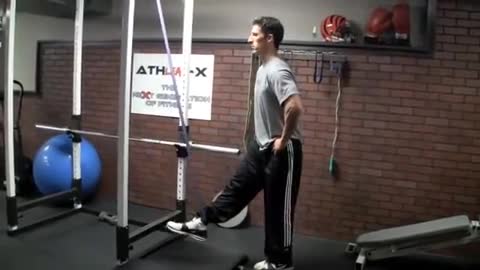
HOW TO DO DECEL LEG SWINGS:
- Anchor a resistance band low on a power rack or any stable surface.
- Place one foot inside the band and stand tall with your core tight.
- With your leg straight, drive it down against the band using your hamstrings.
- The key is the return. Control the upward motion slowly instead of letting the band snap you back. Think of “slamming the brake” with your hamstrings each rep.
WHAT MAKES IT EFFECTIVE: Decel Leg Swings are like a Reverse Standing Leg Curl that train the hamstrings by decelerating force, not just producing it. The band keeps constant tension, so you’re working through the entire range of motion or full ROM. The eccentric control you build here doesn’t just add strength. It bulletproofs the hamstring muscles against pulls and teaches them to function in real-world movements like sprinting and change of direction.
3-WAY HAMSTRING RDLS

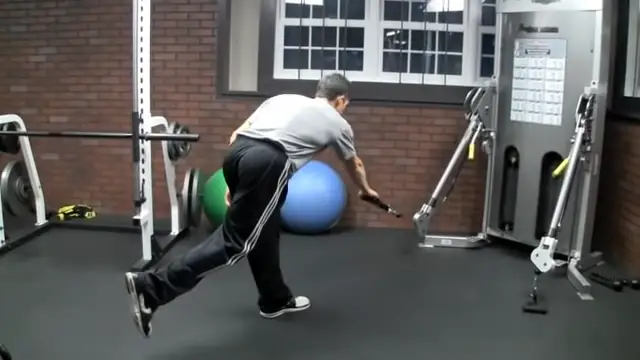
HOW TO DO 3-WAY HAMSTRING RDLS:
- Set up with your feet hip-width apart and grab a cable pulley handle in one hand.
- Balance on the working leg, allowing just a soft bend at the knee to keep it stable.
- Now hinge at the hips, driving your chest forward as the working leg extends back behind you.
- Lower the handle toward the floor with a flat back until you feel a stretch in your hamstrings. Don’t round your spine. Return to the top under control.
- Repeat the same hinge motion three ways: once straight in front, once angling across your body, and once out to the side.
WHAT MAKES IT EFFECTIVE: This isn’t just another RDL. It’s a stability challenge. Working one lower leg at a time lights up your hamstrings and glutes while demanding balance through the core and hips. By moving in three planes, you target different fibers of the posterior chain and expose weaknesses that a straight-line RDL would miss.
PHYSIOBALL CIRCLE CURLS

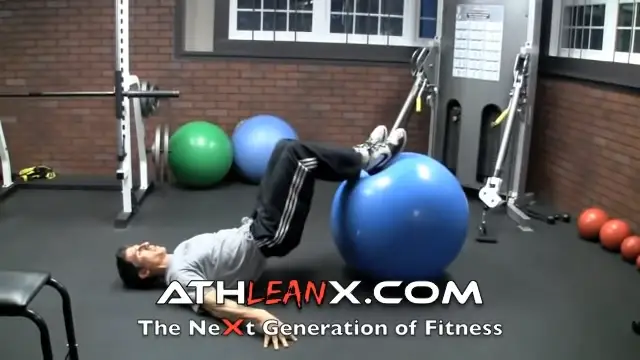
HOW TO DO PHYSIOBALL CIRCLE CURLS:
- Lie flat on your back with your heels resting on a stability ball and your arms braced at your sides.
- Drive through your heels and squeeze your glutes to lift your hips off the ground. Your body should form a straight line from shoulders to knees.
- From here, bend your knees and roll the ball toward you, but instead of pulling it straight in, trace a circle with your feet.
- Perform the same number of reps clockwise and counterclockwise, keeping your hips lifted the entire time.
WHAT MAKES IT EFFECTIVE: This isn’t just a bodyweight exercise Hamstring Curl. It’s a 360-degree challenge. By moving the ball in circles instead of straight in and out, you hit the hamstrings from multiple angles while forcing the glutes to stay locked in a constant contraction. The circular motion also recruits stabilizers in the hips and core, making it much harder to control than a standard curl. The result is stronger hamstrings, better hip stability, and a serious burn through the entire posterior chain.
ASSISTED GLUTE / HAM RAISE

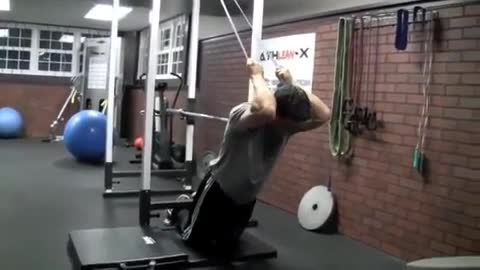
HOW TO DO ASSISTED GLUTE/HAM RAISES:
- Set up a resistance band overhead on a power rack or another sturdy anchor.
- Kneel on the floor with your feet locked under a stable surface. This could be the bottom of the rack, a heavy bench, or anything that won’t move.
- Grab the band for support, brace your core, and keep your body straight from head to knees.
- From here, lower yourself slowly toward the floor, resisting gravity with your hamstrings the entire way down.
- Use the band just enough to stay in control. It’s there to assist, not to do the work.
- Once you’ve reached the bottom, engage your hamstrings and glutes hard to pull yourself back up to the start.
- Stay tight, keep your hips from breaking, and repeat.
WHAT MAKES IT EFFECTIVE: The Assisted Glute Ham Raise nails both sides of hamstring function: eccentric control as you lower and concentric strength as you come back up. The band reduces some of the load so you can train through the full range without collapsing, making it one of the best entry points into learning and performing the brutally hard Nordic Hamstring Curl. It doesn’t just build muscle. It builds resilience, teaching the hamstrings how to decelerate force and then re-accelerate it, exactly what they need to protect you against pulls and tears in real life.
ROMANIAN DEADLIFT

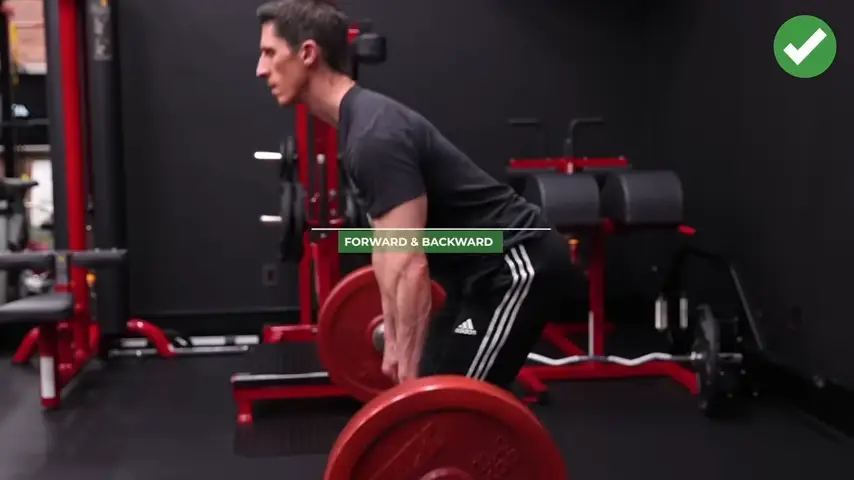
HOW TO DO THE ROMANIAN DEADLIFT:
- Grab the bar just outside shoulder width with a firm overhand grip.
- Plant your feet hip-width apart and lock them into the ground for balance. Before you even move, set your spine with your chest up, shoulders back, and core tight.
- From here, push your hips back like you’re closing a car door with your glutes.
- Keep a soft bend in the knees, but don’t squat. This is a hinge, not a bend-and-pray. The bar should skim your thighs as you lower, never drifting forward.
- Go only as far as your hamstrings let you without your lower back rounding.
- To stand back up, drive your hips forward and squeeze your glutes hard at the top. Drive through your feet as if you’re forcing the floor down, not yanking the bar up. Each rep should move with deliberate control.
WHAT MAKES IT EFFECTIVE: The RDL is one of the best hamstring builders you can do. It loads the hamstrings in their stretched position, forces the glutes to fire, and teaches perfect hip hinge mechanics. It builds size, strength, and resilience across the entire posterior chain. It also carries over to everything from squats to sprints.
DUMBBELL SINGLE-LEG DEADLIFT

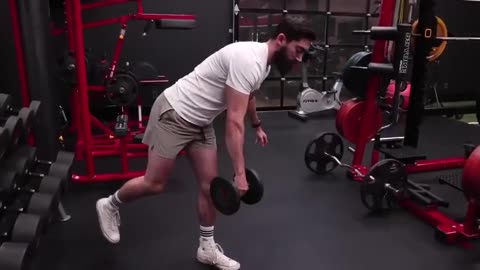
HOW TO DO THE DUMBBELL SINGLE-LEG RDL:
- Stand tall with a dumbbell in each hand, feet about hip-width apart.
- Shift your weight onto one leg and let the other leg hover just off the ground.
- With a soft bend in the working knee, hinge at the hips and lower the dumbbells toward the floor, keeping your chest up and your back flat.
- The non-working leg should extend behind you for balance as you descend.
- When you feel a full stretch through the hamstrings, pause, then drive through your heel and squeeze your glutes to return to standing.
- Reset your balance and repeat.
WHAT MAKES IT EFFECTIVE: This movement hammers the hamstrings and glutes unilaterally, exposing strength differences from side to side that bilateral lifts can hide. The balance component forces your core and stabilizers to stay active, while the hip hinge pattern locks in proper mechanics for safer, stronger training. By training one leg at a time, you’re not only building strength and muscle. You’re bulletproofing yourself against imbalances that lead to injury.
STANDING CUFF KICKBACKS

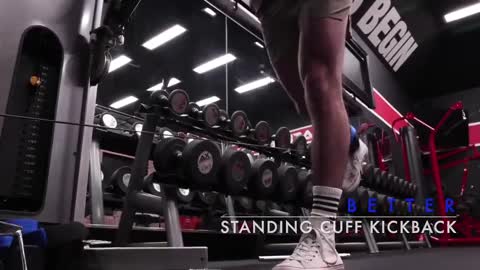
HOW TO DO STANDING CUFF KICKBACKS:
- Strap an ankle cuff to your leg and clip it to a low cable machine.
- Stand tall, brace your core, and hold onto the machine or a stable surface for balance.
- From here, drive your cuffed leg straight back against the resistance, keeping the knee slightly bent and the torso upright.
- Pause briefly at full extension, then return slowly to the start without letting the stack slam down. Every rep should feel smooth and controlled.
WHAT MAKES IT EFFECTIVE: The Standing Cuff Kickback overloads the hamstrings and glutes in a way machines can’t match, forcing constant tension throughout the entire range. Because the movement is isolated, you can really focus on contracting the muscle, making it a great finisher for hypertrophy. The key isn’t heavy weight. It’s control. Slower reps build more time under tension, and that’s where the growth happens. By keeping posture locked in and moving deliberately, you’ll fire the hamstrings, glutes, and stabilizers while minimizing stress on the lower back.
UNLOCK YOUR HAMSTRINGS WITH THESE STRETCHES
Now that you’ve got the best Hamstring Curl alternatives to build strength, you can’t forget the other half of the equation: mobility.
The hamstrings are one of the tightest muscle groups in almost every lifter, and when they’re stiff, your hips lock up, your performance drops, and your risk of injury skyrockets.
Strength without mobility is a dead end.
To keep your hamstrings strong, functional, and resilient, you need to stretch them consistently. Here are the stretches I’d recommend pairing with the hamstring exercises that I discussed above:
LEG SWINGS

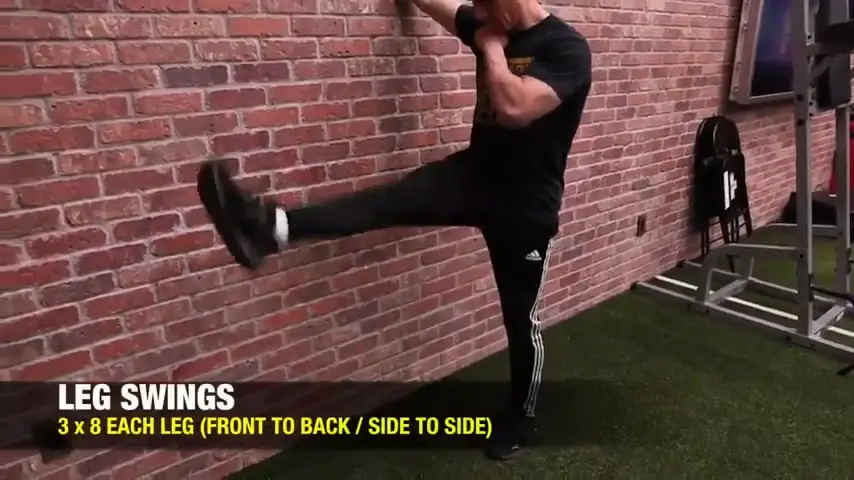
HOW TO DO LEG SWINGS:
- Stand tall next to a wall or rack for balance.
- Keeping your torso upright, swing one leg forward and back in a controlled motion, letting the hamstrings lengthen as the leg comes up and the hip flexors fire as it swings through.
- Start with a smaller range and gradually increase as your muscles loosen up.
WHAT MAKES IT EFFECTIVE: Leg Swings are a dynamic way to prep the hamstrings before training. Instead of holding a static stretch, you’re moving the muscle through its range, warming it up while improving mobility at the hip. This dynamic stretch doesn’t just make the hamstrings feel looser. It primes them for explosive work like sprints, deadlifts, or squats, reducing stiffness and lowering injury risk.
BULGARIAN HAMSTRING STRETCH

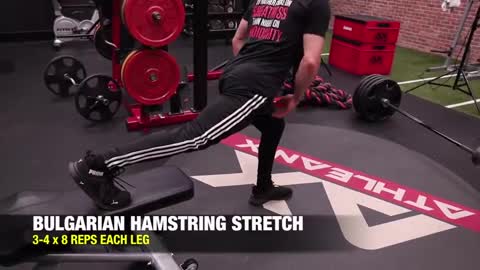
HOW TO DO THE BULGARIAN HAMSTRING STRETCH:
- Set up like you’re doing an exaggerated Bulgarian split squat with one leg forward, the other up on a weight bench behind you.
- Instead of sinking down into a squat, shift your hips back and lean your torso forward.
- Focus on stretching the hamstring of the front floor leg.
- Keep a soft bend in the knee and a flat back as you hinge forward.
- Hold for 20 to 30 seconds, then switch legs.
WHAT MAKES IT EFFECTIVE: This stretch locks in on one hamstring at a time, letting you isolate each side and spot imbalances. Because you’re in a split stance, you not only lengthen the hamstring, but also challenge hip stability at the same time. It’s a deeper, more targeted stretch than standing toe touches and carries over better to athletic positions like sprinting or lunging.
STANDING HIGH HAMSTRING STRETCH

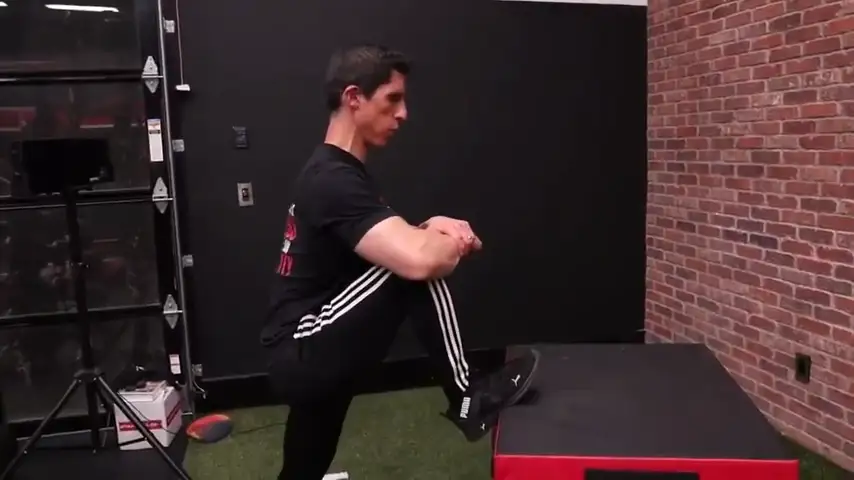
HOW TO DO THE STANDING HIGH HAMSTRING STRETCH:
- Stand tall and lift one knee up in front of you as high as you can, keeping the hip in deep flexion.
- Place your heel on a stable surface at that height like a bench, box, or rail.
- From here, hinge forward slightly at the hips and lean into the stretch.
- Keep a small arch in your lower back and avoid letting the pelvis roll underneath you.
- Hold for 20 to 30 seconds, then switch sides.
WHAT MAKES IT EFFECTIVE: This stretch takes the hamstring into one of its longest positions with your hip flexed high while the leg stays straight. That combination hits the fibers most people never reach with floor or seated stretches. By maintaining spinal position and pelvic control, you not only lengthen the hamstrings but also reinforce proper posture. It’s a powerful way to finish a hamstring stretch sequence and lock in mobility where you need it most.
WALL HINGE

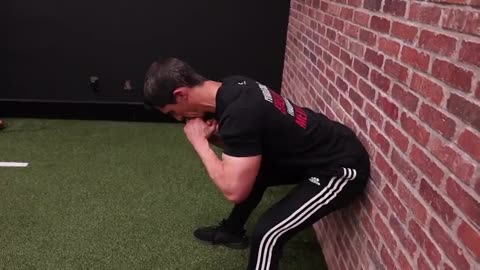
HOW TO DO THE WALL HINGE:
- Stand with your back to a wall and your feet a step or two in front. Your butt should be lightly touching the wall.
- Keep a slight bend in your knees and turn them out slightly.
- From here, hinge forward at the hips while maintaining an anterior pelvic tilt and a natural arch in your lower back.
- Lean forward until you feel a strong stretch through the hamstrings, especially the biceps femoris.
WHAT MAKES IT EFFECTIVE: Unlike straight-leg stretches, the Wall Hinge keeps the knees bent, shifting the stretch deeper into the outer hamstring fibers. The wall also gives you a reference point to keep your hips back and spine neutral, which means better form and less lower back strain.
WALL PLANT STRETCH

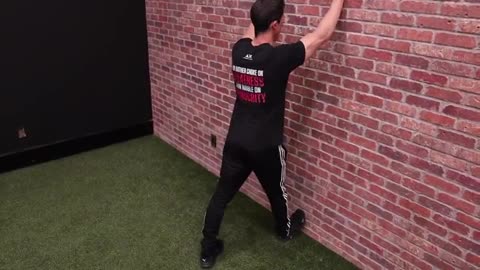
HOW TO DO THE WALL PLANT STRETCH:
- Stand facing a wall and place one heel against it with your leg extended.
- Let your toes point up so the calf and hamstring are both engaged in the stretch.
- From here, hinge forward at the hips while keeping your back flat.
- To deepen the stretch, “climb” your foot higher up the wall as flexibility allows, always staying controlled.
WHAT MAKES IT EFFECTIVE: This stretch combines hamstring and calf lengthening in one move. Since the calf crosses the knee joint, targeting both muscles together creates a more complete stretch through the entire back side of the leg. Using the wall gives you a stable anchor and an easy way to progress over time. Just move your foot higher as mobility improves.
PROGRAMMING HAMSTRING CURL ALTERNATIVES
Training hamstrings isn’t just about picking the right exercise. It’s about putting them in the right place in your workout routine.
The hamstrings work across both the hip and knee, and because they share duties with the glutes and lower back, timing matters if you want performance without breakdown.
Here are some programming tips for your new Hamstring Curl alternatives:
WHEN TO TRAIN THEM
The hamstrings get plenty of background work during squats and deadlifts, but that doesn’t mean you can skip direct strength training.
The key is timing. Hamstring-specific work fits best after your heavy compound lifts, when the big movements have already taxed the muscles and joint condition.
At that point, targeted alternatives like Swiss Ball Rollouts or Standing Cuff Kickbacks can add focused tension without interfering with your main lifts.
On the flip side, if injury prevention or sprint performance is the priority, start your lower-body session with eccentric-based drills such as Decel Leg Swings or the Assisted Glute/Ham Raise.
That way, you prime the posterior chain for power before moving into heavier loading.
HOW OFTEN TO TRAIN THEM
For most lifters, twice per week is the sweet spot.
One day should emphasize heavy, compound movements like the Romanian Deadlift and Dumbbell Single-Leg Deadlift, which build strength and size.
The second day should focus on stability, mobility, and endurance with exercises such as Physioball Circle Curls or Swiss Ball Rollouts.
Adding something like an Assisted Glute/Ham Raise also provides the resilience needed to sprint, jump, and decelerate at full speed without tearing down the muscle.
REP RANGES FOR DIFFERENT GOALS
Rep ranges depend entirely on what you’re chasing.
For raw strength, lower reps work best. Movements like the RDL and Single-Leg Deadlift thrive in the 4 to 6 rep range, where you can push heavier weight while maintaining form.
If hypertrophy is the goal, 8 to 12 reps are where you want to be, especially on unilateral or stability-driven lifts like 3-Way RDLs and Cuff Kickbacks.
For injury prevention and muscular endurance, higher reps (e.g., 12 to 20 reps) are more effective.
Physioball Circle Curls and Swiss Ball Rollouts shine here, as the longer time under tension builds durability without overwhelming the nervous system.
PAIRING WITH OTHER LIFTS
As I’ve mentioned many times, the hamstrings don’t function alone. They work alongside the glutes, core, and lower back.
That means the smartest programming pairs hamstring work with movements that reinforce those relationships.
After a heavy pulling day, adding Swiss Ball Rollouts brings the core and hamstrings together for extra stability.
Following Barbell Squats with Standing Cuff Kickbacks restores balance between quads and hamstrings.
Even warm-ups can benefit from a set of Decel Leg Swings before Olympic lifts or explosive squats. This will wake up the hamstrings and prepare them for high-speed hip extension.
Most lifters lean on the curl exercise machine for hamstrings, but it locks you into isolation and leaves the muscle weak where it matters most.
These smarter alternatives train the hamstrings to extend the hip, decelerate force, and stabilize the entire posterior chain.
Build strength this way and you won’t just have bigger hamstrings. You’ll have hamstrings that perform and protect you in every lift, sprint, and sport.
Check out our complete line of ATHLEAN-RX Supplements and find the best training program for you based on your fitness level and goals.
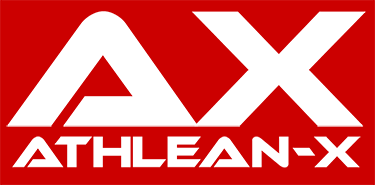
- Leg curls isolate knee flexion, but hamstrings don’t function in isolation. They stabilize hips, extend them, and decelerate force in real movement.
- Seated Hamstring Curl machines load the hamstrings in their shortest, weakest range, leaving them vulnerable to strains and injury.
- The hamstrings’ most important job is powering hip extension during sprints, jumps, and deadlifts. This is something that Hamstring Curls on a weight machine ignore entirely.
- Real strength comes when hamstrings work together with glutes, calves, and core, not when they’re strapped into a seat.
- Overemphasizing curls while quads get heavy compound work widens the strength gap, stressing knees and hips.
- Moves like Romanian Deadlifts, Assisted Glute/Ham Raises, Swiss Ball Rollouts, and Single-Leg Deadlifts train the hamstrings the way they’re meant to function.
- Exercises like Decel Leg Swings and Glute/Ham Raises strengthen hamstrings during lengthened, high-tension positions. These are the exact spots where most injuries occur.
- Swiss Ball Rollouts and Physioball Circle Curls double as core and stability work, training hamstrings to control movement under load.
- Pair strength work with stretches like the Wall Hinge or Bulgarian Hamstring Stretch to keep mobility high and prevent tightness.
- Train hamstrings 2x/week, balance heavy hip-hinges with stability drills, and adjust rep ranges for your goal of strength, hypertrophy, or injury prevention.
HAMSTRING CURL ALTERNATIVES FAQ
The best Hamstring Curl alternatives are the ones that train the muscle the way it actually works.
The hamstrings don’t just bend your knees. They extend your hips, stabilize your pelvis, and control your body every time you sprint, jump, or change direction.
That’s why the smartest choices aren’t isolation moves but compound and eccentric-focused lifts.
The Romanian Deadlift and Dumbbell Single-Leg Deadlift are staples because they load the hamstrings in their stretched position, where most injuries happen and where you need the most strength.
For eccentric control, nothing beats the Assisted Glute/Ham Raise or Decel Leg Swings. Both exercises force your hamstrings to decelerate under load, just like they do during certain sports.
Stability work matters too. Swiss Ball Rollouts and Physioball Circle Curls tie the hamstrings into the core and glutes, challenging them as stabilizers while lengthening the fibers.
The 3-Way Hamstring RDL builds balance and control across different angles, while the Standing Cuff Kickback adds direct overload to round out development.
You don’t need a machine to curl your legs. You just need creativity.
A simple option is the Stability Ball Hamstring Curl: lie on your back, heels on the ball, hips lifted and roll the ball toward you.
This variation not only curls the legs but also forces your glutes and core to work overtime to keep your body straight.
If you don’t have a ball, you can use sliders, towels, or even socks on a smooth floor to get the job done with the same rolling motion.
For advanced lifters, the Nordic Hamstring Curl is the ultimate no-machine option: Anchor your feet under a rack or sturdy surface, lower your body forward under control, and let your hamstrings do the work of slowing you down.
Beginners can modify Hamstring Curls with Assisted Glute/Ham Raises using a resistance band for support. This reduces the load so you can focus on form without collapsing.
Stability Ball or Slider Curls are another beginner-friendly option. They let you train both hip extension and knee flexion at the same time with a manageable level of resistance.
As you get stronger, you can ramp up intensity by slowing the eccentric phase, pausing in the stretched position, or switching to single-leg variations.
Advanced lifters can even add external resistance like a weighted vest or bands to make bodyweight curls more challenging.
REFERENCES
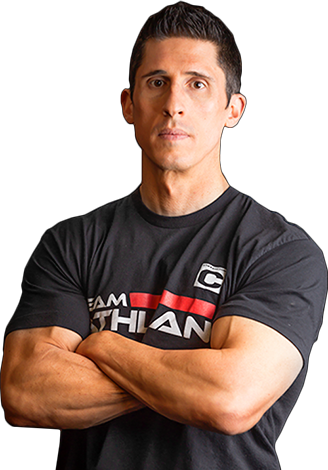
Jeff Cavaliere M.S.P.T, CSCS
Jeff Cavaliere is a Physical Therapist, Strength Coach and creator of the ATHLEAN-X Training Programs and ATHLEAN-Rx Supplements. He has a Masters in Physical Therapy (MSPT) and has worked as Head Physical Therapist for the New York Mets, as well as training many elite professional athletes in Major League Baseball, NFL, MMA and professional wrestling. His programs produce “next level” achievements in muscle size, strength and performance for professional athletes and anyone looking to build a muscular athletic physique.
